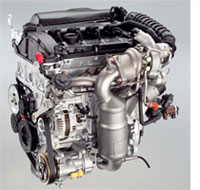 The first fruits of BMW Group and PSA Peugeot Citroën’s collaboration is the Prince Engine, used in a few Peugeot cars like the 307, 207, 207 GT and the upcoming 207 GTI and BMW’s new 2nd generation MINI Cooper and MINI Cooper S (1.6 normally aspirated and turbo variants) as well as the upcoming MINI One (1.4 litre variant).
The first fruits of BMW Group and PSA Peugeot Citroën’s collaboration is the Prince Engine, used in a few Peugeot cars like the 307, 207, 207 GT and the upcoming 207 GTI and BMW’s new 2nd generation MINI Cooper and MINI Cooper S (1.6 normally aspirated and turbo variants) as well as the upcoming MINI One (1.4 litre variant).
The Prince engine family has a 84 mm cylinder spacing and a 77 mm bore, with stroke varied to create two displacements – 1.4 litres and 1.6 litres. The 1.4 litre and 1.6 litre normally aspirated variants feature Valvetronic variable valve timing and a throttle butterfly-less design. The screamer is a 1.6 litre turbocharged variant, featuring a twin scroll turbocharger and gasoline direct injection, without the Valvetronic though. I’ve driven the MINI Cooper S featuring the new 1.6 litre turbocharged engine and it’s really something that takes your breath away – trust me!
The next step – more four-cylinder engine collaborations! We might see larger displacement 1.8 to 2.2 litre four cylinder engines that might end up in cars like the next generation 116i, 120i and the 320i, some of the lower-end BMWs that use four cylinder engines. While nothing is confirmed yet, a joint feasibility study is currently underway to study expected technological, industrial and financial benefits.
Looking to sell your car? Sell it with Carro.



































reading the wikipedia, valvetronic just make valvetrain bulk and complex,
it runs by wire and if the system down, need backed up by throttle butterfly anyway (back to the old reliable), well a bit efficient, but who cares since normal vvt or dual vvt is efficient though..
for me i choose normal throttle butterfly, preferabally individual butterfly for each clyinder, sportyyyyy. and rortyyy, (reliable i guess, imagine the one runs just by steel cable, simple mechanical stuff)
well valve tronic ,according wikipedia ,valvetronic never been used in its M car for bmw,
Eliminating the throttle body butterfly will reduce obstructions in the engine intake (breathing system) making it more efficient (in theory). Less mechanical parts also makes less parts that can wear in time. Might be a good thing.
" I’ve driven the MINI Cooper S featuring the new 1.6 liter turbocharged engine and it’s really something that takes your breath away – trust me!"
Well Paul…give us the full report then!
NST Life & Times has published its test report. Hey! Was that you in the car with Jeremy? He he…
AUTOCAR Asean does theirs in the Jan 2007 issue…so no more media embargo, right? Watcha waiting for dude?
Cheers and happy new year! :)
longdongsilver said,
December 28, 2006 @ 8:09 am
Eliminating the throttle body butterfly will reduce obstructions in the engine intake (breathing system) making it more efficient (in theory). Less mechanical parts also makes less parts that can wear in time. Might be a good thing.
————————————————————-
well throttle is not really an obstruction, just that when WOT (wide open throtttle) thus creating a 'wait' to for air to be sucked into the chamber from a distant throttle body, thus thus to be said a delay in response,
while valvetronic act like variable valve lift, provide ready air, as soon the valve opened to the max the air from the manifold allowed to enter the chamber in no time for each clyinder ,therefore, engine response said to be batter.
well….how batter?
perhaps as good as quad throttle (for 4 clyinder eng.for eg.).where its butterly is close to the intake valve.
efficient? well batter perhaps, since the amount of air entring is instantly calibrated by the the lift of valves for each clynder, accurately,
juat that, the whole operation is by wire and actuator a .., on a complex intake valvetrain,subjected to wear and tear too ………….this is expensiveeee,
efficiency side ….agree, but how efficient?? how much efficiency different from the normal throttle with vvt?? l/100km?, responce ,milisecond?
and ,,well its good ! does it come cheap.?